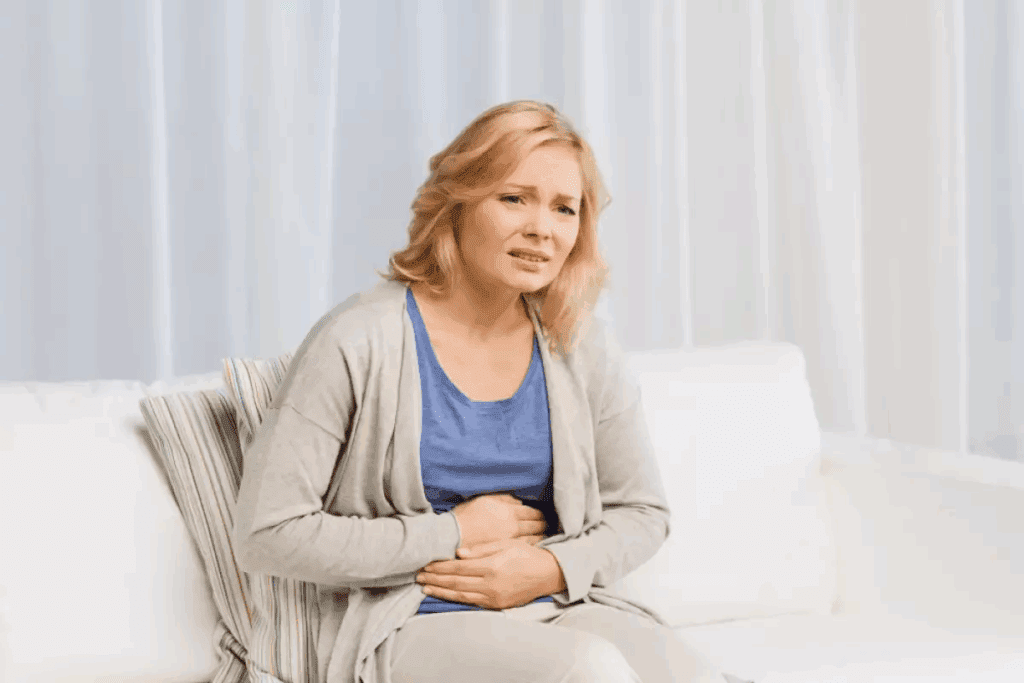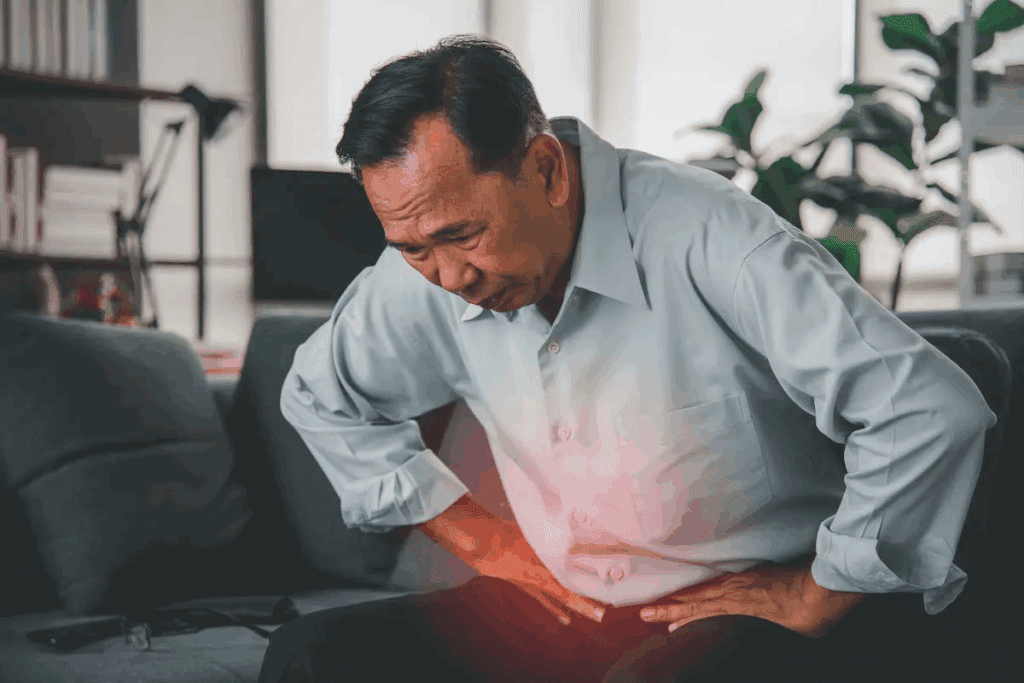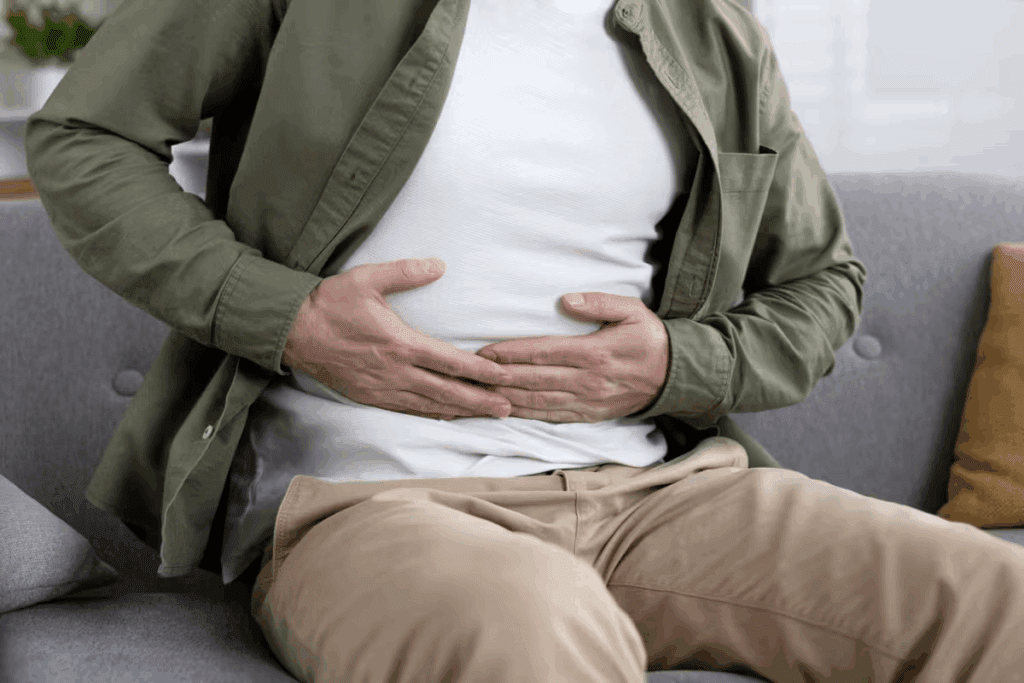Last Updated on November 26, 2025 by Bilal Hasdemir

The gallbladder is a small, pear-shaped organ located beneath the liver. It plays a key role in digestion. Its main job is to store and concentrate bile, a digestive fluid made by the liver.
Bile is key for breaking down fats in what we eat. This makes it a vital part of digestion. The gallbladder helps by storing and concentrating bile. This makes digestion and nutrient absorption more efficient.
Liv Hospital offers reliable information to help you grasp what is the gallbladder do. Knowing about the gallbladder’s function can highlight its importance for our health.

It’s key to know how the gallbladder works and what it looks like to understand its role in digestion. This small, pear-shaped organ sits under the liver. It’s a big part of how we digest food.
The gallbladder is right under the liver. It’s connected to the liver and small intestine by ducts. These ducts help move bile from the liver to the gallbladder and then to the small intestine.
The gallbladder is made to hold bile. It can stretch to hold more or less bile. The lining inside the gallbladder pulls water and salts out of the bile. This makes the bile better at breaking down fats.
The gallbladder works with other organs to digest and absorb nutrients. It gets bile from the liver and sends it to the small intestine. This helps with fat digestion.
| Organ | Function | Relationship to Gallbladder |
| Liver | Produces bile | Supplies bile to the gallbladder for storage |
| Small Intestine | Digests and absorbs nutrients | Receives bile from the gallbladder for fat digestion |
| Gallbladder | Stores and concentrates bile | – |
In short, the gallbladder’s shape and how it connects to other organs show its importance in digestion. It stores and thickens bile, helping to break down fats efficiently.

The gallbladder is key in the digestive system. It stores and concentrates bile, a digestive fluid from the liver. This helps in digesting and absorbing fats properly.
The gallbladder stores bile from the liver and makes it more effective for fat digestion. It removes excess water and electrolytes, making the bile stronger.
Bile Concentration Process: The gallbladder’s role in concentrating bile is vital for fat digestion. By removing water and electrolytes, the bile becomes more potent, helping to emulsify fats better.
The release of bile from the gallbladder into the small intestine is triggered by the hormone cholecystokinin (CCK). This hormone is released when fats enter the duodenum. It ensures bile is released when needed for fat digestion.
The Role of CCK: CCK is essential for signaling the gallbladder to contract and release bile. This hormonal response is vital for the timely release of bile into the small intestine.
The flow of bile into the small intestine is controlled by the sphincter of Oddi. This muscular valve manages the flow of bile and pancreatic juice into the duodenum. It ensures bile is released in the right amount and at the right time.
| Regulatory Mechanism | Function |
| Sphincter of Oddi | Controls the flow of bile and pancreatic juice into the duodenum |
| Cholecystokinin (CCK) | Triggers the release of bile from the gallbladder |
In summary, the gallbladder’s main job is to store and concentrate bile. It releases bile into the small intestine to aid in fat digestion. The regulation of bile flow involves hormonal signals and muscular valves, ensuring efficient digestion.
Learning about bile’s makeup and how it’s made helps us see why the gallbladder is key to good digestion. Bile, made by the liver, is vital for breaking down fats.
Bile is made up of different parts that work together to help digest food. The main parts are:
The liver makes bile, with the help of hepatocytes, the liver’s main cells. Hepatocytes turn cholesterol into bile salts and send them into bile canaliculi. These then join to form bigger bile ducts, leading to the gallbladder for storage.
The gallbladder is key in making bile more concentrated. It takes in water and salts, making bile more potent for fat digestion in the small intestine. This concentration is vital for good fat digestion and vitamin absorption.
In short, bile’s creation and the gallbladder’s role are complex but essential for our health. Understanding these processes shows how important the gallbladder is for our digestion and overall well-being.
The gallbladder is key for fat digestion. It releases bile that breaks down fats, making them easier to absorb. This is vital for good nutrition.
Dietary fats are complex and need to be broken down for absorption. The gallbladder helps by releasing bile. This bile contains bile salts that emulsify fats, turning them into smaller droplets.
This makes fats easier for enzymes like lipase to break down. They turn fats into fatty acids and glycerol. Good fat digestion is key for absorbing essential fatty acids and fat-soluble vitamins.
Fat-soluble vitamins are important for many bodily functions. They help with vision, bone health, antioxidants, and blood clotting. The gallbladder’s role in fat digestion helps with the absorption of these vitamins.
Bile salts emulsify fats and help form micelles. Micelles are important for absorbing fat-soluble vitamins in the intestine. Efficient fat digestion and absorption are vital for maintaining these vitamins at healthy levels.
The gallbladder’s role in fat digestion affects nutrient metabolism. Proper fat digestion helps the body use fats for energy, hormone production, and vitamin absorption. It also supports metabolic health, affecting energy, skin, and immune system health.
In summary, the gallbladder is essential for fat digestion and vitamin absorption. Its dysfunction can cause nutritional deficiencies and metabolic problems. This shows how important it is to keep the gallbladder healthy.
A working gallbladder is essential for avoiding digestive problems with fat. It stores and releases bile, which is key for breaking down fats.
The gallbladder makes sure bile gets to the small intestine on time. This helps break down fats, making vitamins A, D, E, and K easier to absorb. Efficient fat digestion depends on the gallbladder’s ability to store and concentrate bile.
A healthy gallbladder prevents digestive issues by breaking down fats well. If it doesn’t work right, you might feel bloated, nauseous, or have fatty stools. The gallbladder helps avoid these problems by controlling bile release.
A healthy gallbladder also helps absorb nutrients better. It aids in digesting fats, which is key for vitamins A, D, E, and K. These vitamins are important for the immune system, bones, and eyes. The gallbladder’s role in nutrient absorption shows its big role in health.
In short, the gallbladder is key for good digestion. It helps digest fats, prevents discomfort, and ensures nutrient absorption. Knowing its role helps us see why gallbladder health is so important.
The gallbladder is key in our metabolic processes. It helps with cholesterol and gut health. Its role goes beyond just storing and releasing bile, affecting our overall health.
The gallbladder is important for cholesterol management. It stores bile, which contains cholesterol. This helps control cholesterol levels in our bodies.
Implications of Gallbladder Dysfunction: If the gallbladder doesn’t work right, it can cause gallstones or cholecystitis. These issues can make cholesterol problems worse.
New studies show the gallbladder might protect us in ways beyond digestion. It could have anti-inflammatory effects and help control metabolic pathways.
The gallbladder’s role in immune function is being studied. Some research suggests it helps manage our immune response.
The gallbladder also affects our gut microbiome. Bile from the gallbladder shapes the bacteria in our intestines.
In summary, the gallbladder’s role in our health is complex. It involves cholesterol, protection, and a big impact on our gut. Understanding this can help us see why keeping the gallbladder healthy is so important for our overall well-being.
Gallbladder issues are common and can be very uncomfortable. The gallbladder is a small organ under the liver that helps with digestion. But, it can get disrupted by different conditions.
Gallstones are small, hard pieces that form in the gallbladder. They can be made of cholesterol or bilirubin. Sometimes, they don’t cause any pain, but other times, they can lead to severe pain, called biliary colic.
Key risk factors for gallstones:
Cholecystitis is when the gallbladder gets inflamed, often because of gallstones blocking the cystic duct. This can happen suddenly or over time. It can cause severe pain, fever, and nausea.
Chronic cholecystitis happens when you keep getting episodes of acute cholecystitis. This can make the gallbladder wall thick and scarring, affecting its function and causing ongoing digestive problems.
Gallbladder polyps are growths from the gallbladder lining. Most are not cancerous, but some can be. The bigger the polyp, the higher the risk of cancer. They are often found by accident during tests for other reasons.
| Polyp Size | Risk of Malignancy |
| <5 mm | Low |
| 5-10 mm | Moderate |
| >10 mm | High |
Functional gallbladder disorders happen when the gallbladder doesn’t work right without any visible problems. These can cause symptoms like biliary colic. They might be due to how the gallbladder moves or problems with the sphincter of Oddi.
In conclusion, gallbladder problems and disorders include gallstones, cholecystitis, polyps, and functional disorders. Knowing about these conditions is key for diagnosis and treatment. This helps improve patient care.
Knowing the signs of gallbladder problems is key to early treatment. The gallbladder helps with digestion. Issues with it can show up in different ways.
Gallbladder problems often cause pain in the upper right abdomen. This pain can spread to the right shoulder or back. It usually happens after eating fatty meals and can be quite severe.
Key characteristics of gallbladder pain include:
Gallbladder issues can also cause digestive symptoms. These include:
These symptoms can be uncomfortable and affect daily life. If they don’t go away or get worse, you should see a doctor.
In some cases, gallbladder problems can cause more widespread symptoms. These include:
These symptoms mean you need to see a doctor right away. They show a more serious condition.
Seek medical help if you have:
Getting medical help quickly can prevent serious problems and improve your health.
Today, diagnosing gallbladder conditions is more precise than ever. We use advanced methods to understand these diseases fully. This helps us start the right treatment quickly.
Imaging plays a big role in finding gallbladder problems. Ultrasound is often the first choice because it’s safe and shows gallstones and swelling well. Computed Tomography (CT) scans give detailed pictures, spotting serious issues like holes in the gallbladder.
Magnetic Resonance Imaging (MRI) and Magnetic Resonance Cholangiopancreatography (MRCP) help see the bile ducts. They find blockages and other issues. These tools help doctors make the best treatment plans.
“The use of advanced imaging techniques has revolutionized the diagnosis of gallbladder diseases, enabling healthcare providers to offer targeted and effective treatment plans.” –
A leading gastroenterologist
Labs are key in diagnosing gallbladder issues. Liver function tests (LFTs) check how the liver is doing. Bilirubin levels show if the bile ducts are blocked. C-reactive protein (CRP) goes up with inflammation or infection.
Functional tests look at how the gallbladder works. Hepatobiliary iminodiacetic acid (HIDA) scans check if the gallbladder is working right. Endoscopic ultrasound (EUS) gives detailed views of the gallbladder and bile ducts.
| Diagnostic Method | Primary Use |
| Ultrasound | Detection of gallstones and inflammation |
| CT Scan | Identification of complications like perforation |
| HIDA Scan | Assessment of gallbladder function |
By using these modern methods, doctors can accurately diagnose and treat gallbladder issues. This leads to better health outcomes for patients.
There are many ways to treat gallbladder problems. The right treatment depends on the problem’s type and how serious it is. Doctors might use medicine, surgery, or changes in lifestyle to help.
For some gallbladder issues, doctors start with medicine. This can include:
These methods work well for people with mild symptoms or who can’t have surgery.
Surgery is often needed for gallbladder problems, like gallstones. The most common surgery is removing the gallbladder, called cholecystectomy.
There are two main types of cholecystectomy:
Laparoscopic surgery is usually chosen because it heals faster and has fewer risks.
There are also other less invasive treatments for gallbladder problems. These include:
These options are quicker to recover from than traditional surgery.
For the best care, doctors often work together. They include gastroenterologists, surgeons, and radiologists. This team approach makes sure patients get care that fits their needs.
Using different treatments together can lead to better results and fewer complications.
Living without a gallbladder means making lifestyle changes for better digestion. After surgery, the body must adjust to not having this organ. It’s important for storing and releasing bile.
Right after surgery, you might feel pain, discomfort, and digestive problems. These symptoms usually go away with time and the right treatment.
Over time, your body gets used to not having a gallbladder. Bile goes straight from the liver to the small intestine. This can cause:
Your diet is very important when you don’t have a gallbladder. You should:
Here’s an example of what your diet might look like:
| Meal | Recommended Foods |
| Breakfast | Oatmeal with fruits, whole-grain toast |
| Lunch | Grilled chicken, steamed vegetables, quinoa |
| Dinner | Baked fish, brown rice, steamed broccoli |
Some people might face issues like diarrhea or problems with fat digestion after losing their gallbladder. These can be managed with:
The health of the gallbladder is closely tied to what we eat and how we live. Keeping the gallbladder healthy is key for good digestion and overall health. Eating right, making lifestyle changes, and taking preventive steps can help a lot.
Eating lots of fruits, veggies, and whole grains is good for the gallbladder. Foods high in fiber help prevent gallstones by improving bile flow and lowering cholesterol. Also, eating healthy fats like those in avocados and nuts helps the gallbladder work better.
Avoiding foods high in fat and cholesterol is also smart. These can cause problems in some people. Drinking plenty of water is also key, as it helps with digestion and nutrient absorption.
“A healthy diet is key for keeping the gallbladder healthy and avoiding problems.”
Our lifestyle choices greatly affect gallbladder health. Regular exercise helps keep a healthy weight and lowers gallstone risk. Being overweight is a big risk factor for gallbladder disease, so it’s important to manage weight through diet and exercise.
People at high risk of gallbladder disease can take steps to prevent it. Knowing your family history and genetic risks is important. Regular health check-ups and screenings can catch problems early.
Integrative methods, like supplements and alternative therapies, can support gallbladder health. But, always talk to a doctor before starting new supplements or therapies to make sure they’re safe and right for you.
By following dietary advice, making lifestyle changes, and taking preventive steps, we can actively work on keeping our gallbladder healthy. This helps our overall digestive health too.
The gallbladder is key to our digestive health. Its problems can affect our overall well-being. We’ve looked at how it works, its role in fat digestion, and what happens when it doesn’t work right.
Knowing how the gallbladder helps our digestion is important. It helps us understand its role in our health. By eating right and living healthy, we can avoid gallbladder issues.
In short, the gallbladder is very important for our digestive health. It stores and releases bile, helping us digest fats and absorb nutrients. Taking care of our gallbladder helps us stay healthy and feel good.
The gallbladder stores and concentrates bile. This helps with fat digestion and absorption. It’s key for good digestive health.
The gallbladder is vital for digesting fatty foods. Without it, you might feel uncomfortable and have trouble absorbing nutrients.
It stores and concentrates bile from the liver. This bile helps digest fats in the small intestine.
Yes, it affects cholesterol metabolism. It might also protect against some metabolic disorders.
Issues include gallstones, cholecystitis, polyps, and functional disorders.
Look out for pain patterns, digestive symptoms, and other signs. Severe cases need quick medical help.
Doctors use advanced imaging, lab tests, and functional tests. These help find gallbladder problems accurately.
Treatments range from medicine to surgery. This includes traditional and laparoscopic methods, and newer, less invasive options.
The body adjusts after removal. You might notice immediate and long-term digestive changes. You’ll also need to change your diet.
Keep your gallbladder healthy with the right diet and lifestyle. Also, take preventive steps and use integrative care.
Yes, living without a gallbladder is possible. You’ll need to make some diet and lifestyle changes to manage your digestion.
The gallbladder is not essential for survival. But, it’s important for good digestion and nutrient absorption.
Subscribe to our e-newsletter to stay informed about the latest innovations in the world of health and exclusive offers!